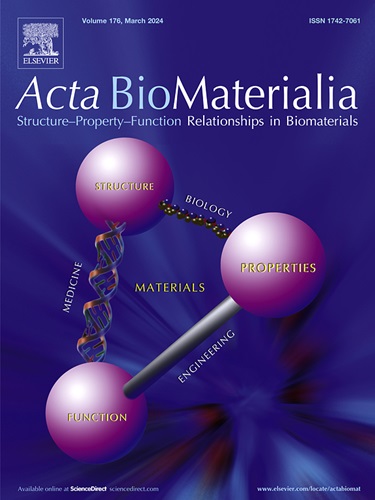ROS-responsive hydrogel for bone regeneration: Controlled dimethyl fumarate release to reduce inflammation and enhance osteogenesis
IF 9.4
1区 医学
Q1 ENGINEERING, BIOMEDICAL
引用次数: 0
Abstract
Large bone defects, often arising from trauma or infection, pose a considerable therapeutic challenge due to their limited capacity for spontaneous healing, thus requiring bone graft materials for effective reparative procedures. The persistence of inflammation and elevated levels of reactive oxygen species (ROS) within these defect sites significantly impede bone regeneration process. Addressing this, an injectable hydrogel system with ROS-responsive functionality is developed, specifically tailored to the high ROS microenvironment characteristic of bone defects. This system incorporates hyaluronic acid functionalized with dopamine to introduce catechol moieties, and employs 4-formylphenylboronic acid as a crosslinking agent to form a dynamic hydrogel matrix (HAC) with carboxymethyl chitosan. The HAC hydrogel serves as a carrier for dimethyl fumarate (DMF), a compound with established anti-inflammatory and antioxidant effects, enabling its controlled release in response to ROS levels. Herein, we investigated the physicochemical properties of DMF loaded hydrogel (DHAC) by microstructure observation, in vitro degradation assay, self-healing test, injectability experiments, DMF drug release assay. Meanwhile, we systematically investigated its effects on inflammation, intracellular ROS, and osteogenesis. Consequently, the DHAC significantly reduced pro-inflammatory cytokines secreted by RAW264.7 cells and scavenged intracellular ROS in MC3T3 cells. This effect was accompanied by an augmentation in the osteogenic potential of MC3T3 cells and a promotion in the repair of cranial defects in rats. The DHAC, which exhibits anti-inflammatory, antioxidant, and osteogenic activity, hold great potential as an effective strategy for the management of large bone defects.
Statement of significance
Here, a novel dimethyl fumarate-loaded ROS-responsive hydrogel system was developed for effective treatment of large bone defects. Our findings demonstrated that the hydrogel not only promotes bone regeneration but also controls inflammation, addressing two critical challenges in bone healing. Comprehensive evaluations show significant improvements in bone formation and reduction of pro-inflammatory cytokines in animal models. Additionally, the hydrogel exhibits excellent reactive oxygen species scavenging ability, effectively modulating oxidative stress in the bone defect microenvironment. Findings suggest the hydrogel system may serve as a promising therapeutic strategy for clinical management of critical-sized bone defects.

求助全文
约1分钟内获得全文
求助全文
来源期刊

Acta Biomaterialia
工程技术-材料科学:生物材料
CiteScore
16.80
自引率
3.10%
发文量
776
审稿时长
30 days
期刊介绍:
Acta Biomaterialia is a monthly peer-reviewed scientific journal published by Elsevier. The journal was established in January 2005. The editor-in-chief is W.R. Wagner (University of Pittsburgh). The journal covers research in biomaterials science, including the interrelationship of biomaterial structure and function from macroscale to nanoscale. Topical coverage includes biomedical and biocompatible materials.
 求助内容:
求助内容: 应助结果提醒方式:
应助结果提醒方式:


